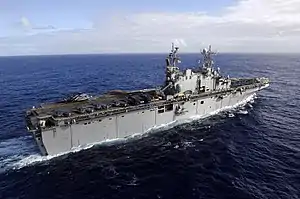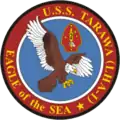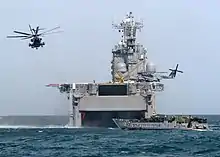USS Tarawa (LHA-1)
USS Tarawa (LHA-1) is a United States Navy amphibious assault ship, the lead ship of her class, and the second ship to be named for the Battle of Tarawa fought during World War II. Tarawa was decommissioned on 31 March 2009, at San Diego Naval Base.[1]
 Tarawa transiting the Pacific Ocean on 11 November 2007 | |
| History | |
|---|---|
| Name: | Tarawa |
| Namesake: | Battle of Tarawa |
| Ordered: | 1 May 1969 |
| Builder: | Ingalls Shipbuilding |
| Laid down: | 15 November 1971 |
| Launched: | 1 December 1973 |
| Sponsored by: | Audrey B. Cushman |
| Acquired: | 14 May 1976 |
| Commissioned: | 29 May 1976 |
| Decommissioned: | 31 March 2009 |
| Homeport: | NB San Diego, California, U.S. |
| Motto: | Eagle of the Sea |
| Nickname(s): | Chicken of the Sea, Kickin' Chicken, Big T |
| Fate: | In reserve at NISMF Pearl Harbor |
| Badge: |
 |
| General characteristics | |
| Class and type: | Tarawa-class amphibious assault ship |
| Displacement: | 38,900 tons |
| Length: | 820 ft (250 m) |
| Beam: | 106 ft (32 m) |
| Draft: | 26 ft (7.9 m) |
| Speed: | 24 knots (44 km/h; 28 mph) |
| Troops: | 2,000+ Marines |
| Complement: | 960+ officers and enlisted |
| Armament: |
|
| Aircraft carried: | Up to 35 Helicopters and 8 AV-8B Harrier II VSTOL aircraft |
History
The ship was laid down in November 1971 at Pascagoula, Mississippi, by Ingalls Shipbuilding, launched 1 December 1973, sponsored by Audrey B. Cushman, the wife of General Robert E. Cushman, former Commandant of the Marine Corps; and commissioned on 29 May 1976, Capt. James H. Morris in command.[2]
Tarawa was the first of five ships in a new class of general-purpose amphibious assault ships, and combined in one ship type the functions previously performed by four different types: the amphibious assault ship (LPH), the amphibious transport dock (LPD), the amphibious cargo ship (LKA), and the dock landing ship (LSD). She was capable of landing elements of a Marine Corps battalion landing team and their supporting equipment by landing craft, helicopters, or a combination of both.[2]
The ship departed Pascagoula on 7 July 1976 and set a course for the Panama Canal. She transited the canal on 16 July and, after a stop at Acapulco, Mexico, arrived at San Diego, California on 6 August. During the remainder of 1976, the amphibious assault ship conducted trials, tests, and shakedown in the southern California operating area. During the first half of 1977, Tarawa was engaged in training exercises off the California coast. On 13 August, she entered Long Beach Naval Shipyard for post shakedown availability, which was completed on 15 July 1978. Following four and one half months of intensive individual ship and amphibious refresher training with embarked marines, Tarawa ended 1978 in her home port of San Diego on Christmas stand down.[2]
Missions
Her first Western Pacific (WESTPAC) deployment came in 1979, where, among other memorable actions including port visits to Pearl Harbor, the Philippines, South Korea, pre-reversion Hong Kong, Singapore, Pattaya, and Okinawa, she successfully engaged in experimental launch and recovery operations with Marine close air support AV-8 Harrier jets and later rescued over 400 South Vietnamese refugees adrift in the South China Sea; her corpsmen delivering Grace Tarawa Tran during the rescue effort, who recently returned to a decommissioned Tarawa in Pearl Harbor to meet the man who delivered her.[3]
After a second deployment WESTPAC, IO, beginning in 1980 and spanning into 1981, Tarawa was in the Indian Ocean.[4]
In 1983, during her third deployment, Tarawa went to the Mediterranean to support the United Nations (UN) peacekeepers in Beirut, Lebanon. Several additional cruises followed.
In 1985 as part of the US 7th Fleet, the Tarawa participated in Operation Valiant Blitz with the US Marines 3rd Marine Division. The 1st. Bn. 7th. Marine Reg. on 6 mo. unit deployment conducted amphibious landing and helo operations off the Coast of Okinawa, Japan, including visits to Hong Kong and Subic Bay for liberty call.
In June 1989, Tarawa deployed for a six-month WESTPAC tour as the 11th Marine Expeditionary Unit (MEU), composed of the Marines from Camp Horno, Camp Pendleton, California, 1st Battalion 9th Marines (redesignated as 2nd Battalion 1st Marines on 9 September 1994).
In December 1990, Tarawa was the flagship of a 13-ship amphibious task force in support of Operation Desert Shield. She participated in the Sea Soldier IV landing exercise in January, which was a deception maneuver suggesting an amphibious assault in Kuwait, and then on 24 February landed Marines in Saudi Arabia just south of the Kuwaiti border.
In May 1991, Tarawa went to Bangladesh in support of Operation Sea Angel, providing humanitarian assistance to victims of a cyclone, delivering rice and water purification equipment.
In May 1992, Tarawa deployed for the eighth time to the Western Pacific, participating in Eager Mace '92–'93, a joint U.S./Kuwait exercise. The ship also supported the insertion of Pakistani troops into Somalia in support of UN humanitarian relief, and returned to San Diego in November 1992. Tarawa was awarded her fourth Admiral Flatley Award and her first Commander, Seventh Fleet, Amphibious Warfare Excellence Award for the '92 deployment. Her 1992 deployment included visits to Hong Kong, Singapore, the Persian Gulf, Somalia, and Australia.
In April 1996, following another complex overhaul at Long Beach Naval Shipyard, Tarawa left from San Diego on its ninth Western Pacific deployment. A U.S./Thailand amphibious training exercise in the Gulf of Thailand, and exercise Indigo Serpent (with the Royal Saudi Navy) and exercise Infinite Moonlight (the first-ever exercise between U.S. and Royal Jordanian Navy) in the Red Sea preceded Tarawa's visit to the Persian Gulf in support of Operation Southern Watch, enforcing the "no-fly zone" over southern Iraq. Tarawa was also part of Operation Desert Strike. Returning to San Diego in October 1996, Tarawa earned both the Federal Energy Conservation Award and the Secretary of the Navy Energy Conservation Award.
February 7, 1998 more than 4,000 Sailors and Marines departed San Diego for a six-month deployment aboard USS Tarawa (LHA 1), USS Mount Vernon (LSD 39) and USS Denver (LPD 9). They departed San Diego five days ahead of schedule as part of a buildup of U.S. forces in the Persian Gulf. The Tarawa Amphibious Ready Group (ARG), consisting of more than 2,100 Marines from the 11th Marine Expeditionary Unit (MEU), operated in the western Pacific, Indian Ocean and the Persian Gulf. Tarawa conducted special operations certification exercises before leaving on their 10th deployment to the Western Pacific. As the possibility of renewed conflict with Iraq loomed on the horizon, the Tarawa ARG made a dash straight to the Persian Gulf within 31 days, at a speed averaging 17 knots. Just as the ARG neared the Persian Gulf, the threat passed. However, according to Commander, Amphibious Group 3, the 12,500-mile, high-speed transit set a record and won the respect of senior Navy officials. USS Tarawa ARG and the 11th MEU arrived in the Persian Gulf March 11, 1998. Tarawa, Denver, and Mount Vernon relieved the USS Guam (LPH 9) ARG to continue the commitment to security and stability in the region. In the early summer of 1998 the Amphibious Ready Group conducted an evacuation operation that rescued 250 people from Eritrea's capital, Asmara. The three-ship returned home August 7 after having spent six months deployed to the western Pacific, Indian Ocean and Persian Gulf.

In mid October 2000, Tarawa was passing through the Strait of Hormuz on her way into the Persian Gulf when the destroyer USS Cole was attacked. On hearing news of the attack, Tarawa came about and steamed full ahead to the Port of Aden in Yemen, where she joined USS Donald Cook, USS Hawes, and the British ship HMS Marlborough, already providing logistical support and harbor security, as the command ship in charge of force protection in what became "Operation Determined Response". Other US Naval ships involved were Catawba, Camden, Anchorage, and Duluth. Tarawa remained with the damaged Cole until she was secure aboard the Norwegian heavy-lift semi-submersible salvage ship MV Blue Marlin for passage to the US before returning to duty in the Persian Gulf.
Part of the film Rules of Engagement (2000) includes scenes of actor Samuel L. Jackson filmed aboard Tarawa.[5]
.jpg.webp)
On 17 January 2001, Tarawa lost its port anchor and chain while being deployed. The Navy used a video of this loss as a training tool to prevent future losses.[6]
On 6 January 2003, Tarawa's Amphibious Ready Group (ARG), carrying the 15th Marine Expeditionary Unit (SOC), departed for deployment. In mid-February, elements of the MEU off-loaded and established a training camp in Northern Kuwait while other members of the MAGTF – primarily the helicopter squadron – remained on board the ARG in the Persian Gulf.
Tarawa deployed from mid-2005 to early 2006 and took her to the Middle East in support of Operation Iraqi Freedom and a multinational training exercise (Operation Bright Star) in Egypt. She transported the 13th Marine Expeditionary Unit. During this deployment, she visited Darwin, Australia, Dubai, UAE, Bahrain, Singapore, and Hong Kong.
She was redeployed in Bangladesh, this time as part of the Cyclone Sidr relief efforts with Kearsarge. The code name for the mission was "Operations Sea Angel II" in recognition of Tarawa's previous support to Bangladesh in 1991. These humanitarian assistance efforts were instrumental in the ship being awarded the 2007 Battle Efficiency Award.[7]
Her last deployment was from 7 November 2007 to 8 June 2008, with the 11th Marine Expeditionary Unit, composed of 1st battalion 5th Marines Charlie and Weapons company, in the Middle East in Support of Operation Iraqi Freedom and Operation Enduring Freedom. She returned to her home port, San Diego, finishing a seven-month deployment. She visited Bangladesh for a third time to offer aid for tsunami victims, Singapore, Bahrain, U.A.E., Djibouti, Perth and Hobart, Australia and Hawaii.
Post decommissioning status
_Crommelin_(FFG-37)_and_Curts_(FFG-38)_laid_up_at_Pearl_Harbor_2013.JPG.webp)
Tarawa was transferred by the USNS Salvor to the Naval Inactive Ship Maintenance Facility at Middle Loch, Pearl Harbor. According to FY2011 plans, two Tarawa-class ships were in Category B Reserve to satisfy Marine Sealift Requirements.[8]
In July 2014 the "US Naval Amphibious Ship Historical Society" was formed by members of Tarawa's commissioning crew (plankowners) with plans to make her the first Navy amphibious ship museum. The organization is executing plans to acquire the ship and give it a permanent home on the West Coast as a museum.[9]
References
- Brandenburg, MC3(SW) David A. (11 September 2008). "Navy to Decommission Tarawa After 32 Years of Honorable Service". US Navy News. Retrieved 6 September 2014.
- "Tarawa II". Dictionary of American Naval Fighting Ships. Navy Department, Naval History and Heritage Command. Retrieved 6 September 2014.
- Logico, MC2(SW) Mark (30 November 2010). "Vietnamese-American Returns to Birthplace - USS Tarawa". US Navy News. Retrieved 6 September 2014.
- "LHA-1 Deployment History 1981 (Declassified)" (PDF). History.navy.mil. Archived from the original (PDF) on 22 May 2013. Retrieved 17 October 2013.
- "CH-46 Sea Knight vs CH-47 Chinook". Retrieved 19 February 2020.
- "YouTube Video, Loss of Port Anchor & Chain".
- "USS Tarawa Awarded Battle "E"". Retrieved 19 February 2020.
- "Report to Congress on Annual Long-Range Plan for Construction of Naval Vessels for FY 2011" (PDF). Military Times. Archived from the original (PDF) on 13 September 2012. Retrieved 6 January 2012.
- "The U.S.S. Tarawa (LHA-1) Amphibious Assault Ship Museum Organization". www.lha1museum.com. Archived from the original on 27 August 2014. Retrieved 26 August 2014.
- This article incorporates text from the public domain Dictionary of American Naval Fighting Ships. The entry can be found here.
- This article includes information collected from the Naval Vessel Register, which, as a U.S. government publication, is in the public domain. The entry can be found here.
External links
| Wikimedia Commons has media related to USS Tarawa (LHA-1). |
